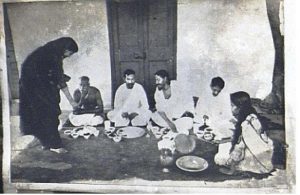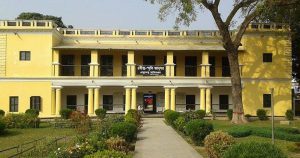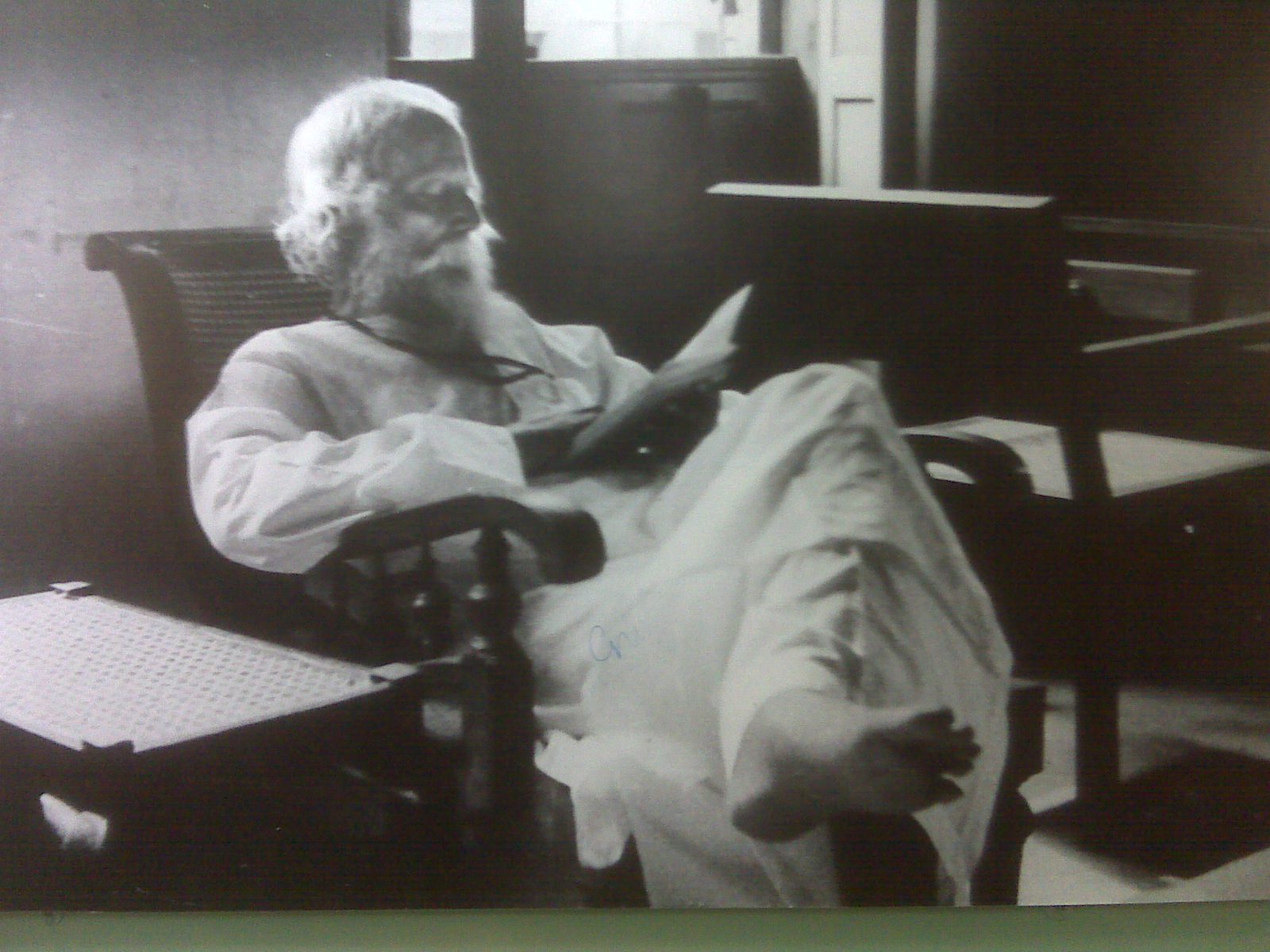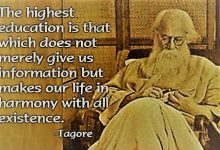
Had there been no stay in East Bengal, Tagore would have been a split soul – a divided personality. A complete and undivided Tagore is that Tagore who is made up of the combination of Calcutta and East Bengal, now Bangladesh. Tagore, however, considered Calcutta and East Bengal as one and the same country—two opposite regions of united Bengal. He could not stand the partition of Bengal (1905) and vehemently opposed it. He was fortunate enough to have died six years before the partition of India (1947) and did not have to suffer the trauma of partition of his beloved motherland. He mustn’t have accepted the bifurcation of his ‘golden Bangla’ done in a fit of the collective religious craze during the declining days of the British Raj manipulated by the tricky imperial powers and the opportunist political leaders, opines Dr. Rashid, as part of the Special Feature, exclusively for Different Truths.
Our greatest literary icon whom we take pride in; share joys and sorrows with and draw inspiration from; whom we recollect in all the seasons of the year, in all the stages of life, and in all the feelings we have—in our well and woe, pleasure and pain, sense and sensibility, and love and war—is none but Tagore—Rabindranath Tagore. As Shakespeare is in English, Victor Hugo in French, Goethe in German, Dante in Italian, Tolstoy in Russian, Galib in Urdu, Ferdowsi in Persian, Kalidasa in Sanskrit—so is Rabindranath in Bengali. The quintessence of our cultural identity! The proud pioneer in the vanguard of our literary progress!
The poetic soul of Rabindranath was a mixture of urban Calcutta and rural Bengal. By Bengal, I would, quite pertinently, like to mean East Bengal. If Calcutta was the making of his brain, Bengal was the making of his heart. The citified environment of Calcutta gave him the warmth of reason while the rustic charm of Bengal gave him the depth of emotion. His life in Calcutta was an experience of a renaissance and his life in Bengal was that of introspection or self-analysis. This perfect blend of sophistication and naivety contributed to the making of the great literary genius. Had there been no stay in East Bengal, Tagore would have been a split soul– a divided personality. A complete and undivided Tagore is that Tagore who is made up of the combination of Calcutta and East Bengal, now Bangladesh. Tagore,  however, considered Calcutta and East Bengal as one and the same country—two opposite regions of united Bengal. He could not stand the partition of Bengal (1905) and vehemently opposed it. He was fortunate enough to have died six years before the partition of India (1947), and did not have to suffer the trauma of partition of his beloved motherland by a hasty political caesarian called ‘two-nation theory’. He mustn’t have accepted the bifurcation of his ‘golden Bangla’ done in a fit of the collective religious craze during the declining days of the British Raj manipulated by the tricky imperial powers and the opportunist political leaders.
however, considered Calcutta and East Bengal as one and the same country—two opposite regions of united Bengal. He could not stand the partition of Bengal (1905) and vehemently opposed it. He was fortunate enough to have died six years before the partition of India (1947), and did not have to suffer the trauma of partition of his beloved motherland by a hasty political caesarian called ‘two-nation theory’. He mustn’t have accepted the bifurcation of his ‘golden Bangla’ done in a fit of the collective religious craze during the declining days of the British Raj manipulated by the tricky imperial powers and the opportunist political leaders.
Tagore’s sojourn in East Bengal began in 1890 with his coming over here to look after his paternal estate spread over three places — Shelaidah of Kushtia, Sahzadpur of Pabna and Patisar of Natore. He savoured every moment with obvious relish in the lap of nature— in the exotic green fields and on the floating boats. He discharged his official duties towards the naïve tenants as a benevolent zamindar and devoted himself to writing in profusion.
He came in touch with the folk singer Gagan Harkara through whom he gained access to the esoteric world of Fakir Lalon Sain’s Baul music that he later popularised. This period from 1891 to 1895 has been called ‘Sadhana period’ which was named after the name of one of his magazines, and Tagore himself admitted that it was ‘the most productive period’ in his literary life, and he ‘enjoyed the greatest freedom [his] life has ever known’. During this period, he wrote a large number of poems, stories, essays, and letters. More than half of the stories of Galpaguchchha were written at that time which depicted the people of East Bengal living in grinding poverty. Selected extracts from the letters written during his stay in three places of Bangladesh—Shelaidah, Shahjadpur, and Patishar were translated into English and published in a book titled Glimpses of Bengal. They testify to his feeling about the beauty of nature in East Bengal along with her people and culture.
In the introduction to the book, Tagore discussed the whys and wherefores of the letters. They “span the most productive period of [his] literary life”. He felt “the writing of letters… to be a delightful necessity” which he considered as “a form of literary extravagance only possible when a surplus of thought and emotion accumulates”. The selected and translated extracts from a large number of letters “found their way back to [him] years after they had been written. They had delighted him “by bringing to mind the memory of days when… [he] enjoyed the greatest freedom [his] life” in rural Bengal. The descriptions contained in those letters are characteristic of East Bengal (now Bangladesh) and have been of great interest to the English audience.
Rabindranath lives and shall live in the hearts and minds of the Bengali and the people of Bangladesh forever. They are inseparable from each other. Rabindranath’s ethnicity, i.e. Bengali nationalism has been adopted as one of the four basic pillars of the constitution on which the nation-state called Bangladesh was built on. To commemorate his deep-rooted association with Bangladesh, one of his songs has been made the national anthem of Bangladesh. There had been and still are numerous conspiracies to separate Rabindranath from Bangladesh but to no avail. Bangladesh and Rabindranath are the Siamese twin tied to each other with an umbilical cultural cord. To try to separate the two by an artificial surgery under any ideological or political duress would sure lead to a cultural disaster. To keep Bangladesh socially, culturally, and politically healthy, we must fall back on Tagore at all times.
The establishment of the long-awaited Rabindra University in Bangladesh is sure a milestone on the road towards cultural preservation through higher education, which is now at the top of the postcolonial agenda. The premier herself had laid the foundation stone of the university in Shahjadpur on the morning of Kabiguru’s 154th birth anniversary. It is expected to be erected after the fashion of the Santiniketan  Visva-Bharati University and to grow as a centre of excellence in teaching and research on the multifarious aspects of this literary genius’s life and work. This will lead to fresh discoveries and rediscoveries, which must help us map our cultural heritage and consolidate our position in the globe.
Visva-Bharati University and to grow as a centre of excellence in teaching and research on the multifarious aspects of this literary genius’s life and work. This will lead to fresh discoveries and rediscoveries, which must help us map our cultural heritage and consolidate our position in the globe.
In addition, the study of Tagore and Bangladesh will motivate younger generations to blend our past convictions with future promise. Rabindranath, for the Bengali, is not one to escape notice. He is well worth something to feel with the heart, to put into the head, and to translate into reality; something to write and to read– in private and in public—in the academia and out of the academia! A revival of interest in Tagore has appeared on the literary scene of Bangladesh and the world as well. With the growing cultural awareness in this post-colonial era, the Bengali-speaking people, especially the younger generation, have developed a renewed interest in Tagore. The 150th anniversary of his birth had been celebrated throughout the Bengali-speaking world with boundless enthusiasm. UNESCO had declared 2011 as the ‘Year of Tagore’. In its wake, the world attention is being hugely focused on Tagore, Bangladesh, and Bengali language.
Photos from the Internet
#TagoreInBangladesh #UndividedTagore #BengalAndTagore #Tagore #University #TributeToTagore #DifferentTruths





 By
By
 By
By
